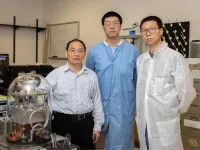(Press-News.org) The more time spent on social media, the greater the likelihood that children and young people will both smoke and/or vape, suggests research published online in the respiratory journal Thorax.
Clocking up a weekday tally of 7 or more hours was associated with a more than a doubling in risk among 10 to 25 year olds, the findings indicate, reinforcing concerns about the marketing clout of these platforms, say the researchers.
The existing body of research on social media use and smoking and vaping mostly concerns the USA, so to better assess the situation in the UK, the researchers drew on data from 10 to 25 year olds taking part in the UK Household Longitudinal Study 2015–21.
Participants were asked to report their normal weekday social media use as well as current cigarette smoking and vaping activity.
Among 10,808 participants with a total of 27,962 reported observations, just over 8.5% reported current cigarette smoking in at least one survey, and 2.5% reported current vaping. Just over 1% reported dual use.
Analysis of the responses showed that cigarette smoking, vaping, and dual use were all more common among participants reporting heavier social media use.
Just 2% of those who said they didn’t use social media reported current cigarette smoking compared with nearly 16% of those who said they spent 7 or more hours/weekday on it.
Similarly, current vaping ranged from less than 1% among non-users of social media to 2.5% among those spending 7 or more hours on it every weekday.
The likelihood of smoking, vaping, and dual use also rose in tandem with the amount of time spent on social media.
Those who said they spent less than 1 hour/day on social media were 92% more likely to be current smokers than those who said they spent no time on it, while those clocking up 7 or more hours/day were more than 3.5 times as likely to be current smokers.
And those who said they spent 1–3 hours a day on social media were 92% more likely to report current vaping than those who said they spent no time on it.
And those spending 7 or more hours/day on social media were nearly 3 times as likely to report current vaping than those who said they didn’t spend any time on these platforms.
Heavier social media use was associated with a greater likelihood of dual use. Those reporting spending 1–3 hours/day on it were more than 3 times as likely to be dual users as those who said they didn’t spend any time on social media.
But those spending 7 or more hours/day on social media were nearly 5 times as likely to both smoke and vape.
The findings were independent of other factors associated with a heightened risk of smoking and vaping, including age, sex, household income, and parental smoking and vaping.
When the analysis was broken down by sex and household income, similar associations emerged for smoking, but not for vaping. Males, those under the legal age of sale, and those from higher income households were more likely to vape.
This is an observational study, and as such, no firm conclusions can be drawn about causal factors. The researchers also acknowledge that the study relied on self reported data, and that they didn’t have any information on the social media platforms used, or how they were being used. But they proffer some explanations for their findings.
“First, and most straightforwardly, there is evidence that the corporations behind cigarette smoking and vaping make use of social media to advertise and promote their products,” write the researchers.
“This includes direct advertising which is algorithmically targeted and the use of paid social media influencers who present smoking and vaping as a fashionable and desirable activity. Greater time spent on social media is likely to increase exposure to these forms of influence,” they explain.
“Second, social media use has been shown to have features in common with reward-seeking addictive behaviour.High social media use may increase susceptibility to other addictive behaviours like smoking,” they add.
“Third, as a space that is largely unsupervised by parents/caregivers, social media use may encourage behaviours that are transgressive, including cigarette smoking and vaping.”
They conclude: “The companies that own social media platforms have substantial power to modify exposure to material that promotes smoking and vaping if they choose to or are compelled to. Voluntary codes seem unlikely to achieve this, and the introduction and enforcement on bans on material that promote this should be considered.
“In general, we think that algorithms should not be promoting products to individuals that they cannot legally buy. Legislation and enforcement around this and other corporate determinants of health concerns should be considered a core part of online safety and child protection.”
In a linked editorial, Dr Kim Lavoie of the University of Montreal, voices concerns about the popularity of e-cigarettes and vaping products among young people.
Aside from the addictive nature of nicotine and the relative affordability and accessibility of these products, “the answer may lie in the subtle and creative ways e-cigarette manufacturers have managed to reach, and entice, youth into taking up vaping,” which include social media, she suggests.
“The policy implications of this paper are important, particularly as they pertain to regulation of advertising and algorithms targeting under-age users,” she writes.
END
Likelihood of kids and young people smoking and vaping linked to social media use
7+ daily hours associated with more than doubling in risk among 10 to 25 year olds. Findings reinforce concerns about marketing clout of these platforms, say researchers
2024-05-17
ELSE PRESS RELEASES FROM THIS DATE:
Global life expectancy to increase by nearly 5 years by 2050 despite geopolitical, metabolic, and environmental threats, reports new global study
2024-05-17
**Embargo: 23.30 [UK time], 6:30 p.m. [EDT] May 16, 2024**
Global Burden of Disease
The latest findings from the Global Burden of Disease Study (GBD) 2021, published today in The Lancet, forecast that global life expectancy will increase by 4.9 years in males and 4.2 years in females between 2022 and 2050.
Increases are expected to be largest in countries where life expectancy is lower, contributing to a convergence of increased life expectancy across geographies. The trend is largely driven by public health measures that ...
High primary health coverage significantly reduces child mortality in Latin America
2024-05-17
The implementation of primary health care (PHC) over the last two decades has prevented more than 300,000 child deaths in four Latin American countries, and could prevent more than 140,000 by 2030 in a scenario of economic crisis. This is the main conclusion of a study coordinated by the Barcelona Institute for Global Health (ISGlobal), a centre supported by “la Caixa” Foundation, published in The Lancet Global Health.
The 2018 Astana Declaration highlighted the critical role of PHC in ensuring that everyone enjoys the highest possible standard of health, and in achieving universal health coverage. The Declaration also stressed the ...
Ubiquitin trailblazer elected Fellow of prestigious Royal Society
2024-05-17
WEHI division head and pioneer of ubiquitination Professor David Komander has been elected a Fellow of the esteemed Royal Society, the UK’s national science academy.
Prof Komander was recognised for his significant research contributions towards understanding ubiquitin, the ‘kiss of death’ protein which tells our cells which proteins to break down or recycle – a vital process that helps cells stay healthy and function correctly. Prof Komander’s work has helped unravel the ‘ubiquitin code’ that enables ubiquitin to perform many ...
A new ‘rule of biology’ may have come to light, expanding insight into evolution and aging
2024-05-17
By Darrin S. Joy
A molecular biologist at the USC Dornsife College of Letters, Arts and Sciences may have found a new “rule of biology.”
A rule of biology, sometimes called a biological law, describes a recognized pattern or truism among living organisms. Allen’s rule, for example, states that among warm-blooded animals, those found in colder areas have shorter, thicker limbs (to conserve body heat) than those in hotter regions, which need more body surface area to dissipate heat.
Zoologist Joel Allen formulated this idea in 1877, and though he wasn’t the first or the last to present a rule of biology, his ...
Scripps Research chemists develop new method for making gamma chiral centers on simple carboxylic acids
2024-05-17
LA JOLLA, CA—Scripps Research chemists have accomplished a long elusive feat in synthetic chemistry: the invention of a broadly useful method for constructing “gamma chiral centers” on simple starting compounds called carboxylic acids. The method, published on May 16, 2024 in Science, significantly extends the ability of chemists to build and modify complex pharmaceutical molecules and other valuable chemical products.
The term chiral refers to a type of asymmetry that allows some chemical compounds to exist in left-handed and right-handed forms. Often, only one of these forms has the ...
2024 SIAM Annual Meeting (AN24) with online component including SIAM Conference on Discrete Mathematics (DM24) and the SIAM Conference on Applied Mathematics in Education (ED24)
2024-05-16
The SIAM Annual Meeting provides a broad view of the state of the art in applied mathematics, computational and data science, and their applications through invited presentations, prize lectures, minitutorials, minisymposia, contributed presentations, and posters. END ...
Detecting influence campaigns on X with AI and network science
2024-05-16
In the age of generative-AI and large language models (LLMs), massive amounts of inauthentic content can be rapidly broadcasted on social media platforms. As a result, malicious actors are becoming more sophisticated, hijacking hashtags, artificially amplifying misleading content, and mass resharing propaganda.
These actions are often orchestrated by state-sponsored information operations (IOs), which attempt to sway public opinion during major geopolitical events such as the US elections, the Covid-19 pandemic, and more.
Combating ...
Offering both colonoscopy and at-home tests doubled colorectal cancer screening
2024-05-16
The rate of colorectal cancer screenings more than doubled when patients were given a choice between which type of screening they wanted—a take-home kit or colonoscopy—compared to those who were only offered the colonoscopy, according to new research led by the Perelman School of Medicine at the University of Pennsylvania. Facilitated through a community health center in which about half of patients had Medicaid insurance, the study—published in Clinical Gastroenterology and Hepatology—provides insights about how to boost screenings among groups ...
A powerful tool speeds success in achieving highly efficient thermoelectric materials
2024-05-16
HOUSTON, May 16, 2024 – Thermoelectric materials could play an important role in the clean energy transition, as they can produce electricity from sources of heat that would otherwise go to waste without generating additional greenhouse gases or requiring large up-front investment. But their promise has been slowed by the fact that most current thermoelectric materials don’t efficiently produce enough power to be useful for many practical applications.
The search for new, more efficient materials involving complex chemical ...
Oropharyngeal cancer staging health record extraction using AI
2024-05-16
About The Study: The results of this study suggest that artificial intelligence may be associated with enhanced patient care and oncological decision-making in patients with oropharyngeal squamous cell carcinoma through detection of localized versus advanced cancer stages. Further model refinement and external validation with electronic health records at different institutions are necessary to improve algorithm accuracy and clinical applicability.
Corresponding Author: To contact the corresponding author, Antoine Eskander, M.D., email antoine.eskander@mail.utoronto.ca.
To access the ...
LAST 30 PRESS RELEASES:
Making lighter work of calculating fluid and heat flow
Normalizing blood sugar can halve heart attack risk
Lowering blood sugar cuts heart attack risk in people with prediabetes
Study links genetic variants to risk of blinding eye disease in premature infants
Non-opioid ‘pain sponge’ therapy halts cartilage degeneration and relieves chronic pain
AI can pick up cultural values by mimicking how kids learn
China’s ecological redlines offer fast track to 30 x 30 global conservation goal
Invisible indoor threats: emerging household contaminants and their growing risks to human health
Adding antibody treatment to chemo boosts outcomes for children with rare cancer
Germline pathogenic variants among women without a history of breast cancer
Tanning beds triple melanoma risk, potentially causing broad DNA damage
Unique bond identified as key to viral infection speed
Indoor tanning makes youthful skin much older on a genetic level
Mouse model sheds new light on the causes and potential solutions to human GI problems linked to muscular dystrophy
The Journal of Nuclear Medicine ahead-of-print tip sheet: December 12, 2025
Smarter tools for peering into the microscopic world
Applications open for funding to conduct research in the Kinsey Institute archives
Global measure underestimates the severity of food insecurity
Child survivors of critical illness are missing out on timely follow up care
Risk-based vs annual breast cancer screening / the WISDOM randomized clinical trial
University of Toronto launches Electric Vehicle Innovation Ontario to accelerate advanced EV technologies and build Canada’s innovation advantage
Early relapse predicts poor outcomes in aggressive blood cancer
American College of Lifestyle Medicine applauds two CMS models aligned with lifestyle medicine practice and reimbursement
Clinical trial finds cannabis use not a barrier to quitting nicotine vaping
Supplemental nutrition assistance program policies and food insecurity
Switching immune cells to “night mode” could limit damage after a heart attack, study suggests
URI-based Global RIghts Project report spotlights continued troubling trends in worldwide inhumane treatment
Neutrophils are less aggressive at night, explaining why nighttime heart attacks cause less damage than daytime events
Menopausal hormone therapy may not pose breast cancer risk for women with BRCA mutations
Mobile health tool may improve quality of life for adolescent and young adult breast cancer survivors
[Press-News.org] Likelihood of kids and young people smoking and vaping linked to social media use7+ daily hours associated with more than doubling in risk among 10 to 25 year olds. Findings reinforce concerns about marketing clout of these platforms, say researchers



